The biggest question facing the Toronto Maple Leafs this summer is what they’re going to do with Mitch Marner. Set to become a restricted free agent on July 1, Marner and his agent, Darren Ferris, are reportedly looking for a huge payday. With Nikita Zaitsev and Patrick Marleau still on the books, the Maple Leafs don’t have a ton of cap space at this point. With new contracts also owed to RFAs Andreas Johnsson and Kasperi Kapanen, general manager Kyle Dubas won’t want to break the bank on Marner.
How Dubas handles the situation remains to be seen, but there should be an upper limit on what he is willing to pay his star winger. We’ve previously discussed what Marner is worth according to comparables around the league, so Dubas would be wise to stay within that $9-$10 million range. If Marner’s camp, however, refuses to settle for a reasonable number, the threat of them accepting an offer sheet can’t be ignored. Although the NHL hasn’t seen an offer sheet since 2013, it may finally be time for a shakeup with at least 15 high profile RFAs looking for new deals this summer.
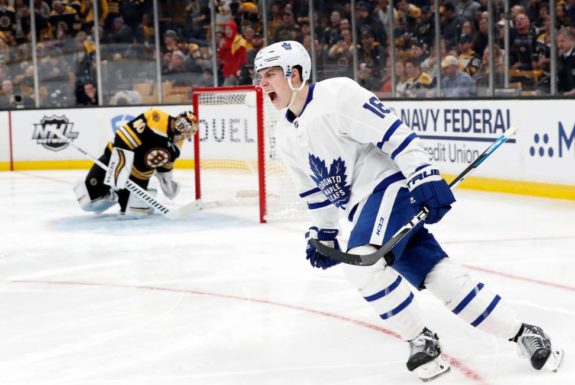
If Marner is offered a contract that Dubas cannot match, it will be a big blow to the team: Losing your top point-scorer and a fan favourite is never a good thing. Fortunately, there are plenty of other options for the Maple Leafs to pursue in case they do lose Marner. Let’s face it: an extra $10 million in cap space and four first-round picks goes a long way.
That said, let’s dive into five fun things that the Maple Leafs could do if Marner accepts an offer sheet.
Re-Sign Jake Gardiner
Starting with the most realistic (and maybe least exciting) option, the Maple Leafs would have sufficient cap space to re-sign Jake Gardiner. Despite receiving his fair share of criticism from fans over the years, Gardiner has been one of the team’s top defencemen since joining the team in 2011-12.

If you need a refresher on just how valuable Gardiner has been to the team, I’ve got you covered. But in short, the Minnesota-native has been arguably the team’s best defenseman at even strength during his entire tenure. Yes, even better than Morgan Rielly.
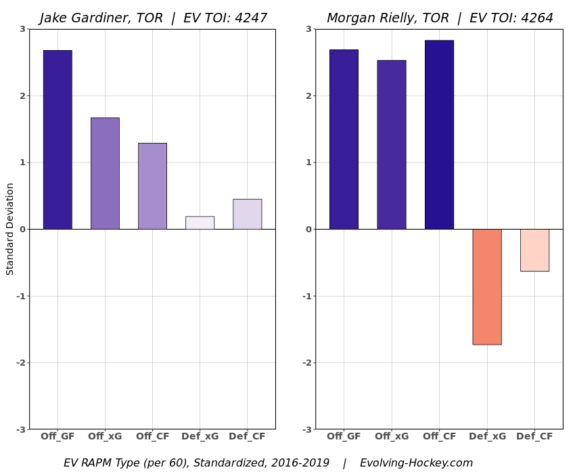
The real issue surrounding Gardiner will be his health moving forward. He dealt with relatively serious back issues this season, missing 20 games between February and the end of the regular season. He returned to the lineup in time for the playoffs but was clearly still hurt, averaging just 16:10 of ice time, down from 21:21 in the regular season.
If the Maple Leafs and their medical staff determine that Gardiner will make a full recovery and can return to peak performance, it would be sensible to re-sign him. He’s turning 29 in July so he will be exiting his prime shortly, but Gardiner should still have at least three or four good seasons left in him.
Evolving Wild has him at a projected cap hit of $6.95 million over seven years, which may sound a bit rich. But with Gardiner and the Maple Leafs keeping their options open, there is a possibility of signing him to another team-friendly deal, allowing them to use that extra cap space to improve in other areas.
Sign Artemi Panarin
The 27-year-old Russian needs no introduction. He is the most dynamic forward available in free agency this summer, scoring 87 points in 79 games this past season. Since entering the league with the Chicago Blackhawks in 2015-16, Panarin is a top-10 scorer with 320 points in 322 games. Every team in the NHL should be interested in acquiring his services and if Marner leaves, the Maple Leafs should have more than enough cap space to make a run at Panarin.
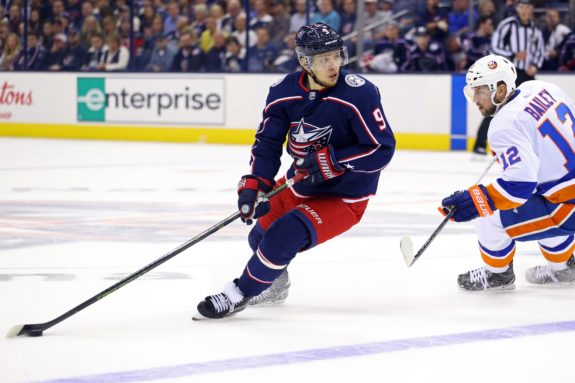
There are some counterarguments to signing Panarin. For one, the strategy of building a team through free agent signings isn’t the most prudent: unrestricted free agents like Panarin have more leverage than anyone else, as multiple teams compete for their services they become the most expensive.
The Maple Leafs already have nearly $30 million tied up in their three highest-paid forwards. Adding Panarin to the mix, with his $11.38 projected cap hit, means that four players would be eating up half of the Maple Leafs’ cap space. On the other hand, the Maple Leafs won the John Tavares sweepstakes last summer and while it did cost them $11 million per season, it’s not a deal that anyone in Toronto will be regretting any time soon.
That same mentality could and should be applied to Panarin. He’s still in his prime at 27 years old and has slightly outproduced Tavares over the past three seasons. Adding another legitimate top-10 NHL player is never a bad thing, and he would arguably be an upgrade over Marner, at least in the short term.
Sign Erik Karlsson
When is the last time a generational player hit the open market? It just doesn’t happen in the NHL. The aforementioned Tavares left the New York Islanders to sign with the Maple Leafs last summer, but somehow Erik Karlsson is going to one-up him this offseason.
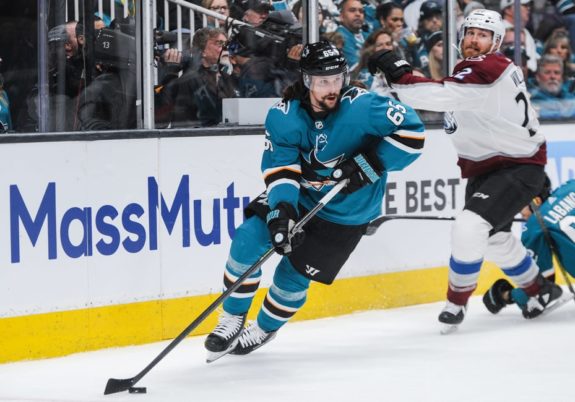
Even in a down season riddled with injuries, Karlsson managed to score 45 points in 53 regular season games, followed by 16 points in 19 playoff appearances. The 29-year-old underwent groin surgery on June 5 and is expected to fully recover for the start of the 2019-20 season. His health is a concern moving forward, with ankle and Achilles injuries also affecting him in recent years, but Karlsson is so good that even at less than 100%, he’s probably still the best defenseman in the league.
From 2015-16 to 2017-18, Karlsson led defencemen in points-per-60 (P/60) at even strength with a mark of 1.67. At all strengths, he ranked second at 2.03. Only Brent Burns produced at a higher rate with 2.1 P/60. But unlike Burns, Karlsson helps his team at both ends of the ice and has a far superior impact on possession and shot rates.
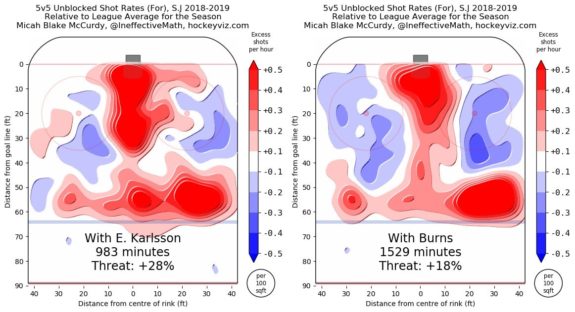
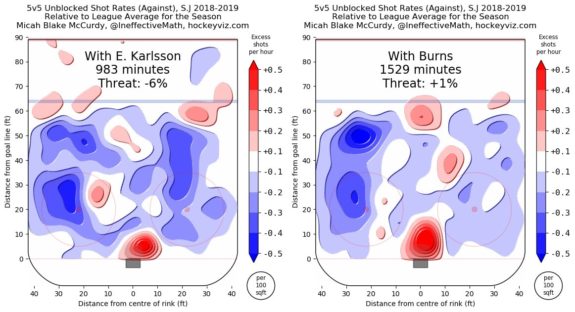
Despite Karlsson’s reputation as a pure offensive defenseman, he defends very well. On top of that, his marks of 59.3% Corsi-For this season and 53.4% career average tell us that the puck is in the offensive zone far more than it’s in the defensive zone when Karlsson is on the ice. He’s a game-changer in every way imaginable and there’s almost no limit to his value to a hockey team.
Evolving Wild’s projected cap hit of $9.9 million seems conservative, but any team that has the cap space should offer Karlsson essentially whatever he wants. He would immediately solve the Maple Leafs’ defensive issues with his ability to play 25-plus minutes per night on the right side.
If you’re still not sold, think of it this way: the Maple Leafs losing Marner and signing Karlsson would be like trading Marner for Karlsson plus four first-round picks. That’s a deal you take while laughing all the way to the bank.
Offer Sheet Another RFA
While the chance of an offer sheet is unlikely given the NHL’s history, Marner signing an offer sheet would likely open up the floodgates. With so many good, young players hitting restricted free agency this offseason, the Maple Leafs have plenty of options for retaliation if it comes to that.
For reference, here are the compensatory picks for offer sheets this offseason:
What this means is that despite not having their first-round pick for the 2019 NHL Entry Draft, the Maple Leafs are still eligible to offer sheet anyone they wish, as they still have all their picks for 2020 and on.
Brayden Point
Perhaps the best candidate to receive an offer sheet from the Maple Leafs would be Tampa Bay Lightning centre Brayden Point. Coming off a ridiculous 41-goal, 92-point campaign, Point will likely be looking for a monstrous contract. Evolving Wild has him at a projected cap hit of $8.24 million, but that’s on a five-year deal. If the Calgary-native opts for more term, he should be closing in on the $10 million range, if not more. As a centre and 40-goal scorer, his market value should probably be higher than Marner’s, despite conflicting mainstream narratives.
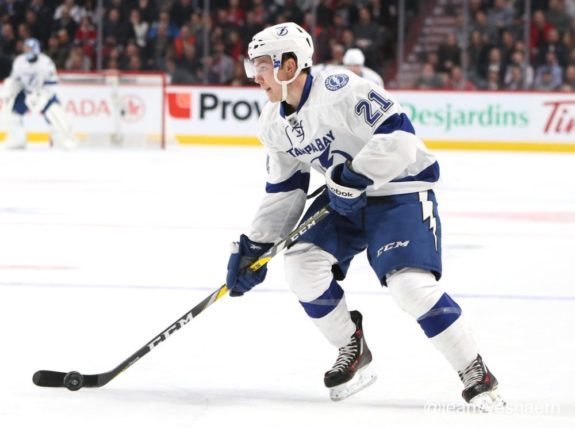
Where things get interesting is when we look at the Lightning’s cap situation: They have just $8,576,669 in projected cap space for next season. If they can convince Point to sign a reasonable deal for low to moderate term, then they may be able to retain him, but if the Maple Leafs, for instance, swoop in with a more lucrative offer, Point may accept and put the Lightning in a tough situation.
Charlie McAvoy
Charlie McAvoy has already developed into a legitimate top-pairing defenseman at just 21 years of age. As a right-handed shot, he’s exactly the type of player that the Maple Leafs need to complete their defensive corps.

McAvoy is projected to earn $7.26 million on a six-year term, which is pretty reasonable for a player of his age and caliber. With $14,303,334 in cap space, the Boston Bruins should have enough room to re-sign their top defenseman. However, the Maple Leafs may believe that McAvoy still has room for growth and is worth more money (and multiple draft picks). If they offered McAvoy something in the range of $10 million over five years they would only have to give up two first, a second, and a third round pick. It also would put immense pressure on the rival Bruins to either match or let McAvoy walk.
Brandon Carlo
If the McAvoy scenario doesn’t appeal to the Maple Leafs, they can try another Bruins defenseman in Brandon Carlo. The 22-year-old put up just 10 points in 72 regular season games this season but at 6-foot-5, he has become a pillar (literally and figuratively) for Boston on defense. While Carlo is a downgrade from McAvoy, he is still young and has shown the ability to play in a top-four role. He’s also another right-hand shot defenseman, which the Maple Leafs sorely need.

Carlo is projected to earn just $4.31 million per year on a six-year deal, but like McAvoy, an offer sheet from the Maple Leafs might entice him to leave. Depending on how much McAvoy signs for, there may not be enough money leftover for Carlo.
Timo Meier
While he hasn’t been mentioned much in discussions about the top RFAs, Timo Meier had a quietly dominant year with the San Jose Sharks, scoring 30 goals and 66 points in the regular season while adding 15 points in 20 playoff games. At 6-foot, 210 pounds, Meier mixes his skill with a heavy, power-forward style that the Maple Leafs are sorely lacking.
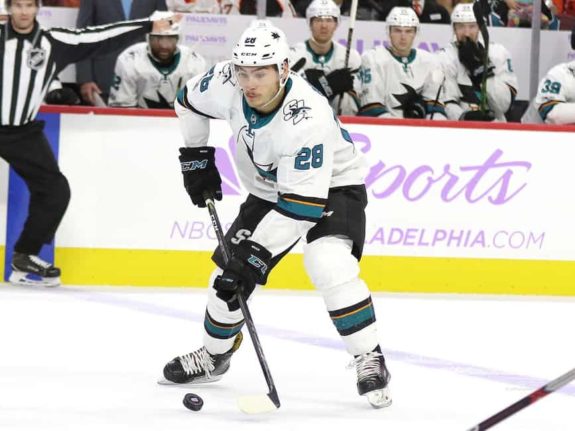
The San Jose Sharks are in a tricky situation in regards to their cap. They have several notable unrestricted free agents to re-sign in Joe Pavelski, Joe Thornton, Gustav Nyquist, Joonas Donskoi, and possibly Karlsson. While their $24,703,333 of projected cap space may sound like a lot, it will be eaten up very quickly, especially if Karlsson decides to return. That leaves the Sharks susceptible to offer sheets on their top-tier RFAs, and Meier could be lured away by a strong enough offer.
Evolving Wild predicts that the Swiss winger is worth $5.89 million on a six-year contract. The Maple Leafs could offer Meier something in the ballpark of $8 million per year for six years, giving up two firsts, a second, and a third-round pick. They could even get creative and offer $10 million with a four-year term, only losing a first, second, and third. Not bad for a 22-year-old who still has plenty of room for growth.
Make a Big Trade
Finally, if all else fails, the Maple Leafs would be armed with about $20 million in cap space (assuming Patrick Marleau and Nikita Zaitsev are moved), four extra first-round picks, and some valuable players and prospects to attack the trade market with.
Consulting TSN’s trade bait board, there are a few enticing names that the organization may be interested in.
| PLAYER | AGE | POSITION | CAP HIT | YEARS |
| 1. Phil Kessel (PIT) | 31 | RW | $6.8M | 3 |
| 2. Jacob Trouba (WPG) | 25 | RD | $5.5M | RFA |
| 3. Ryan Callahan (TBL) | 34 | RW | $5.8M | 1 |
| 4. Jason Zucker (MIN) | 27 | LW | $5.5M | 4 |
| 5. P.K. Subban (NSH) | 30 | RD | $9M | 3 |
| 6. Michael Frolik (CGY) | 31 | LW | $4.1M | 1 |
| 7. Connor Brown (TOR) | 25 | RW | $2.1M | 1 |
| 8. Kyle Turris (NSH) | 29 | C | $6M | 5 |
| 9. Kevin Shattenkirk (NYR) | 30 | RD | $6.65M | 1 |
| 10. Artemi Panarin (CBJ) | 27 | RW | $6M | UFA |
| 11. Travis Hamonic (CGY) | 28 | RD | $3.86M | 1 |
| 12. Nikita Zaitsev (TOR) | 27 | RD | $4.5M | 5 |
| 13. Olli Maatta (PIT) | 24 | LD | $4.08M | 1 |
| 14. Colin Miller (VGK) | 26 | RD | $3.88M | 3 |
| 15. Milan Lucic (EDM) | 30 | LW | $6M | 4 |
The most fitting players on this list include Jacob Trouba, Jason Zucker, P.K. Subban, and Colin Miller. Trouba, Subban, and Miller can be placed into the same category: They are all top-four (or better) right-handed defensemen, and because of their handedness they all fit the Maple Leafs’ needs.
Miller would likely be the easiest to acquire via trade as the Vegas Golden Knights are reportedly open to moving him and his $3.88 million cap hit is very team friendly. We’ve discussed how good of a fit he’d be in Toronto in a previous post, and his relatively low trade value makes him even more attractive.
Trouba has historically had a rocky relationship with the Winnipeg Jets’ front office, previously requesting a trade in 2016, although it never materialized. Now an unsigned RFA, Trouba is on the market again and depending on the asking price, the Maple Leafs may be interested.
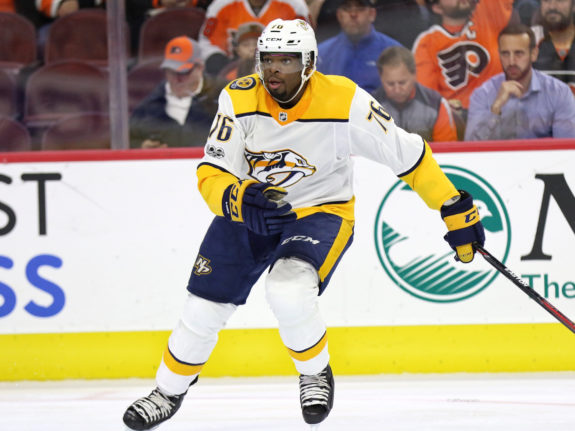
Subban, the most high-profile defenseman on the list, is probably the most polarizing player as well. He scored just 31 points in 63 games this season and having just turned 30, is likely past his prime. His cap hit of $9 million per year is also hard to swallow. Being a Toronto-native, Subban’s connection to the Maple Leafs will always be there, but the team would be better served spending their money and assets on younger, more affordable pieces.
One name that’s missing from TSN’s list is Carolina Hurricanes defenseman Dougie Hamilton. Turning 26 this June, Hamilton is still a young player and has already scored 40-plus points four times in his career (just barely missing the mark this season with 39 points). The defensively stacked Hurricanes are apparently looking to offload a defenceman this summer, and Hamilton will surely be one of the names that teams will be asking about.
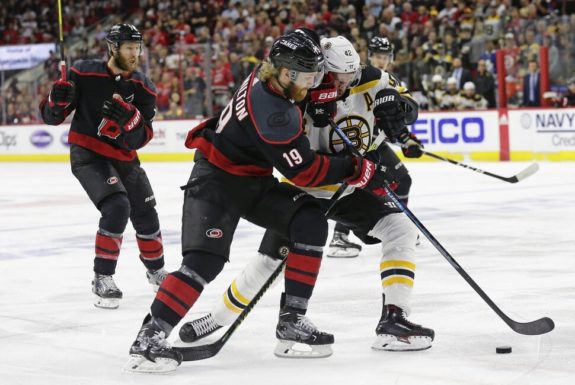
Zucker is the one forward on this list who could catch the Maple Leafs’ attention, but the asking price from Minnesota Wild GM Paul Fenton is understandably high. Pittsburgh Penguins star winger Phil Kessel has been the most prominent name attached to the Zucker trade. It was reported that the teams actually had a one-for-one trade in place, but Kessel nixed it. Zucker is arguably one of the best two-way wingers in the league, previously recording 33 goals and 64 points in 2017-18. His cap hit of $5.5 million is more than palatable, but if the asking price is a player of Kessel’s quality, the Maple Leafs may not want to pay up.
Don’t Fear the Offer Sheet
The point here was not to provide realistic options for the Maple Leafs to consider this offseason. The point is that in the unlikely case Marner receives and accepts an offer sheet that the Maple Leafs can’t or won’t match, there are still plenty of routes that the team can take to fill the void, and in some cases actually improve.
The crux of the issue comes down to the fact that offer sheets simply don’t happen in the NHL, whether due to the cost of compensatory picks or just the stigma associated with backstabbing a fellow general manager. Given reports that the Maple Leafs are likely going to trade a couple of cumbersome contracts, they’ll have plenty of space to re-sign Marner.
And what all of this ultimately means is that Marner has less leverage than it may seem.
Player stats from naturalstattrick.com, hockey-reference.com, and hockeydb.com
All contract projections from https://hockey-graphs.com/2019/05/17/projecting-nhl-skater-contracts-for-the-2019-offseason/